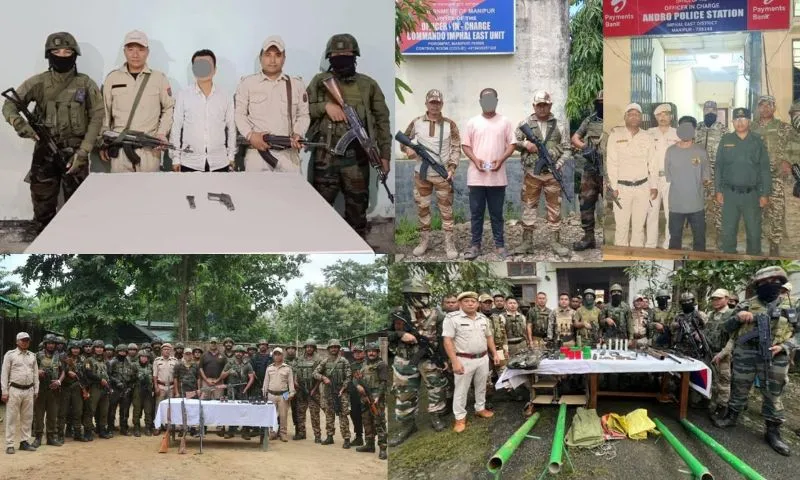Manipur: Security Forces Arrest 3 Insurgents, Bust Camps & Recover Huge Cache of Arms
Security forces in Manipur launched coordinated anti-insurgency operations on Monday that led to the arrest of three active insurgent cadres belonging to banned outfits and the discovery and dismantling of multiple militant camps. The arrested men — identified by police as Oinam Somenchandra Singh (alias Macha / Langamba / Moirangjao), Phanjoubam Ramananda Singh (alias Tiger Panamba), and Thongam Indrajit Meitei — were taken into custody in different parts of the Imphal Valley; police say they were involved in extortion targeting shops and the public, and recovered a pistol and mobile phones from them. In separate but linked operations security forces also busted camps at Singtom (Kakching) and between Chaudharykhal (Jiribam) and Savomphai (Pherzawl), seizing a large arsenal that included INSAS rifles, an AK-47, mortars, pistols, grenades, IEDs and tactical equipment.
Who was arrested and where (names, aliases, and affiliations)
- Oinam Somenchandra Singh (41) — known by aliases Macha / Langamba / Moirangjao; identified as an active cadre of the outlawed Kangleipak Communist Party (PWG). He hails from Thanga Karang Mamang Leikai in Bishnupur district and was arrested from Taothong Khunou under Lamsang Police Station jurisdiction.
- Phanjoubam Ramananda Singh (23) — known as Tiger Panamba; identified with the PLA (People’s Liberation Army) and arrested from Huikap Makha Leikai under Andro Police Station, Imphal East.
- Thongam Indrajit Meitei (33) — affiliated with KCP (MFL) (another proscribed faction), arrested from Takhel Mamang Leikai under Lamlai Police Station, Imphal East.
These arrests cover multiple banned outfits and multiple pockets of the valley — a pattern that’s been consistent in recent months where small cells operate semi-independently but share resources. Local reporting confirms that these cadres have been involved in extortion and other funding activities that sustain underground operations.
What was recovered from the arrested suspects (immediate seizure)
From the three men taken into custody, police recovered one pistol with a magazine and three mobile phones. While the hardware seized on a suspect’s person can look modest, those phones and that single pistol are often the tip of the iceberg — phones contain networks, call records, contacts and locations that lead investigators to camps, caches, and handlers. In other words: a small seizure in hand can open doors to much bigger discoveries.
The camp busts: where security forces struck and the scale of the haul
Beyond the arrests, several coordinated operations located and dismantled insurgent camps and unearthed a substantial weapons and materiel stockpile. The NENow report breaks down two major caches that were recovered during the sweep:
Singtom village (Sugnu Police Station, Kakching district) — a camp was busted and the following items were seized: one INSAS rifle with an empty magazine, one bolt-action rifle, two 51mm mortars, two country-made carbines, one .32 pistol (empty magazine), seven improvised explosive devices (IEDs), four Pompi launchers, 56 live rounds of assorted calibres, 25 empty cartridges, four tear smoke shells, two tear smoke grenades, a Baofeng handset (radio), a bulletproof cover, tactical boots and a waist belt.
Between Chaudharykhal (Jiribam district) and Savomphai (Pherzawl district) — another cache dismantled under Borobekra Police Station revealed a heavier assortment: one 7.62mm AK-47, one 5.56mm INSAS light machine gun (LMG), one .303 rifle, one single-barrel rifle, one 9mm pistol, two No. 36 grenades, 36 rounds of ammunition, four handheld radios, and multiple magazines.
Why the mix of recovered items is worrying (and what it tells us about militant intent)
Let’s decode the inventory like a detective would:
- Assault rifles (AK-47, INSAS, SLR/.303): These provide firepower suitable for ambushes, area denial, or pitched skirmishes. The presence of different rifle families suggests access to multiple supply chains or cross-border procurements.
- Mortars and Pompi launchers: These are force-multipliers — they allow militants to engage from distance, create panic, or target lightly defended positions without direct contact.
- IEDs and grenades: Improvised devices and grenades indicate a readiness to conduct asymmetric attacks and booby-trapping of routes — a classic insurgent tactic to slow or deter security responses.
- Handheld radios and Baofeng sets: Communications gear means these groups coordinate — they’re not lone wolves. Radios point to command-and-control, tactical planning, and the ability to move or regroup quickly.
FAQs
Q1: Are the arrested men linked to a single group or multiple banned outfits?
Police reports indicate the three arrested individuals were affiliated with different proscribed outfits (KCP (PWG), PLA and KCP (MFL)), so they are not from a single homogeneous group. This multiplicity makes intelligence and coordination across districts essential.
Q2: How dangerous are the recovered weapons — could they have been used in large attacks?
Yes. The seized inventory (assault rifles, mortars, grenades, IEDs and radios) could have equipped small units to carry out targeted attacks, ambushes or terror actions. The presence of mortars and IEDs is particularly concerning because those elements create asymmetric threat capabilities.
Q3: Should local civilians be worried about reprisals after giving information to police?
While reprisals are a valid fear in conflict-affected areas, police and security agencies increasingly employ anonymous tip lines and secure liaison mechanisms. Civilians should report suspicious activity through official channels and community policing units, and authorities should prioritize witness protection where risks are identified.
Q4: Can recovered weapons be traced to their origin?
With forensic marking of weapons and ballistic analysis, many arms can be traced to origins or prior incidents. However, insurgents sometimes alter serial numbers or source arms through informal cross-border channels, which complicates tracing. Strengthening forensic capacity and cross-border cooperation helps.
Q5: What role can ordinary citizens play in reducing the threat?
Citizens can help by staying observant, reporting suspicious caches or strangers loitering in sensitive areas, supporting honest businesses against extortion (reporting demands) and cooperating with community policing initiatives. Even small inputs — a picture of a suspicious vehicle, a time and place, or a phone number — can give investigators critical leads.





